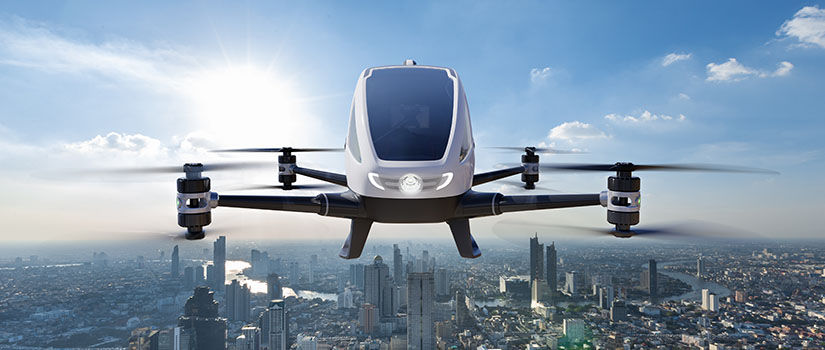The College of Engineering and Computing (CEC) is assisting in NASA’s objective to explore new ways of moving people and goods by supporting aircraft development for emerging aviation markets.
Through NASA’s University Leadership Initiative (ULI), the University of South Carolina’s McNair Center for Aerospace Innovation and Research entered a partnership three years ago with the University of Southern Mississippi, Boise State University and Benedict College. In partnership with Boeing, Collins Aerostructures, Joby Aviation, Toray Advanced Composites, Schrodinger, Litzler, Smart Tooling and Navy ManTech, which serve on the USC Industrial Advisory Board, the university is helping to reimagine the design of urban air mobility vehicles through the Atoms to Aircraft to Spacecraft (A2A) project.
Urban air mobility vehicles, also known as air taxis, are four-to-five person vehicles that run on electric power, have vertical takeoff and landing capabilities, and are intended to fly approximately 150 miles. They are expected to enter the air travel market in 2025.
“Air taxis will be a big market, and making aerospace quality composites that are light weight, strong, and impact resistant at high rates was not achievable in the past. Through our collaborations, we are inventing new materials and manufacturing methods tailored to high-rate manufacturing for this emerging market,” says Paul Ziehl, CEC associate dean for research.
The A2A project will make urban air mobility vehicles possible by increasing the production rate. USC’s approach will leverage their expertise in thermoplastic composites, which can be assembled without fasteners through the electromagnetic process of fusion welding to enable higher production rates. It can also be disassembled and recycled unlike the thermostatic composites used for current aircraft. Thermoplastic composites are generally tougher and more impact resistant than the more widely used thermoset composites.
A focus of the project is education and training to grow a highly skilled knowledge-based workforce in materials and structures for the emerging air taxi market. USC has been highly successful in placing graduates in desirable aerospace and related jobs. The university’s project leadership team includes four graduates of the aerospace engineering program: Assistant Professor Wout De Backer, Darun Barazanchy, Jaspreet Pandher and Joshua Widawsky.
“Up to 20% of the weight of aircraft components today that are made of composites may be due to metallic fasteners. The technologies our team is working on will move away from metallic fasteners to reduce weight and increase the speed of manufacturing,” Ziehl says. “This year, our team will manufacture demonstrators for a rotor blade and part of the fuselage with new approaches developed at USC.”
CEC Dean Hossein Haj-Hariri added that receiving one of the coveted NASA ULIs is a testament to the McNair Center’s excellence.
“In an impressively short period, the McNair Center has become a household name in the aerospace composites world as well as robotics and predictive maintenance,” says Haj-Hariri. “The center continues to pursue and receive similarly competitive and prestigious funding in all its areas, and educates, trains, and produces highly sought graduates that are at the forefront of their respective disciplines.”
